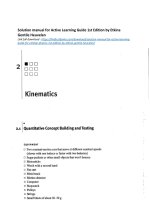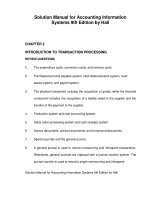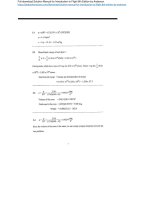Solution manual for the intel microprocessors 8th edition by brey
Bạn đang xem bản rút gọn của tài liệu. Xem và tải ngay bản đầy đủ của tài liệu tại đây (686.92 KB, 55 trang )
Chapter 12: Interrupts
Solution Manual for The Intel Microprocessors 8th Edition by Brey
Introduction
Link download full:
/>
• In this chapter, the coverage of basic I/O and
programmable peripheral interfaces is expanded
by examining a technique called interruptprocessed I/O.
• An interrupt is a hardware-initiated procedure
that interrupts whatever program is currently
executing.
• This chapter provides examples and a detailed
explanation of the interrupt structure of the entire
Intel family of microprocessors.
The Intel Microprocessors: 8086/8088, 80186/80188, 80286, 80386, 80486 Pentium,
Pentium Pro Processor, Pentium II, Pentium, 4, and Core2 with 64-bit Extensions
Architecture, Programming, and Interfacing, Eighth Edition
Barry B. Brey
Chapter Objectives
Upon completion of this chapter, you will be able to:
• Explain the interrupt structure of the Intel
family of microprocessors.
• Explain the operation of software interrupt
instructions INT, INTO, INT 3, and BOUND.
• Explain how the interrupt enable flag bit (IF)
modifies the interrupt structure.
• Describe the function of the trap interrupt flag bit
(TF) and the operation of trap-generated tracing.
The Intel Microprocessors: 8086/8088, 80186/80188, 80286, 80386, 80486 Pentium,
Pentium Pro Processor, Pentium II, Pentium, 4, and Core2 with 64-bit Extensions
Architecture, Programming, and Interfacing, Eighth Edition
Barry B. Brey
Copyright ©2009 by Pearson Education, Inc.
Upper Saddle River, New Jersey 07458 • All rights reserved.
Chapter Objectives
(cont.)
Upon completion of this chapter, you will be able to:
• Develop interrupt-service procedures that
control lower-speed, external peripheral
devices.
• Expand the interrupt structure of the
microprocessor by using the 82S9A
programmable interrupt controller and
other techniques.
• Explain the purpose and operation of a real-time
clock.
The Intel Microprocessors: 8086/8088, 80186/80188, 80286, 80386, 80486 Pentium,
Pentium Pro Processor, Pentium II, Pentium, 4, and Core2 with 64-bit Extensions
Architecture, Programming, and Interfacing, Eighth Edition
Barry B. Brey
12–1 BASIC INTERRUPT
PROCESSING
• This section discusses the function of an
interrupt in a microprocessor-based system.
• Structure and features of interrupts available to
Intel microprocessors.
.
The Intel Microprocessors: 8086/8088, 80186/80188, 80286, 80386, 80486 Pentium,
Pentium Pro Processor, Pentium II, Pentium, 4, and Core2 with 64-bit Extensions
Architecture, Programming, and Interfacing, Eighth Edition
Barry B. Brey
The Purpose of Interrupts
• Interrupts are useful when interfacing I/O
devices at relatively low data transfer rates,
such as keyboard inputs, as discussed in
Chapter 11.
• Interrupt processing allows the processor to
execute other software while the keyboard
operator is thinking about what to type next.
• When a key is pressed, the keyboard encoder
debounces the switch and puts out one pulse that
interrupts the microprocessor.
The Intel Microprocessors: 8086/8088, 80186/80188, 80286, 80386, 80486 Pentium,
Pentium Pro Processor, Pentium II, Pentium, 4, and Core2 with 64-bit Extensions
Architecture, Programming, and Interfacing, Eighth Edition
Barry B. Brey
Figure 12–1 A time line that indicates interrupt usage in a typical system.
– a time line shows typing on a keyboard, a
printer removing data from memory, and a
program executing
– the keyboard interrupt service procedure,
called by the keyboard interrupt, and the
printer interrupt service procedure each take
little time to execute
The Intel Microprocessors: 8086/8088, 80186/80188, 80286, 80386, 80486 Pentium,
Pentium Pro Processor, Pentium II, Pentium, 4, and Core2 with 64-bit Extensions
Architecture, Programming, and Interfacing, Eighth Edition
Barry B. Brey
Interrupts
• Intel processors include two hardware pins
(INTR and NMI) that request interrupts…
• And one hardware pin (INTA) to acknowledge the
interrupt requested through INTR.
• The processor also has software interrupts
INT, INTO, INT 3, and BOUND.
• Flag bits IF (interrupt flag) and TF (trap flag),
are also used with the interrupt structure and
special return instruction IRET
– IRETD in the 80386, 80486, or Pentium
The Intel Microprocessors: 8086/8088, 80186/80188, 80286, 80386, 80486 Pentium,
Pentium Pro Processor, Pentium II, Pentium, 4, and Core2 with 64-bit Extensions
Architecture,
Programming,
and Interfacing,
Eighth Edition
Barry B. Brey
Interrupt Vectors
• Interrupt vectors and the vector table are
crucial to an understanding of hardware and
software interrupts.
• The interrupt vector table is located in
the first 1024 bytes of memory at addresses
000000H–0003FFH.
– contains 256 different four-byte interrupt vectors
• An interrupt vector contains the address
(segment and offset) of the interrupt service
procedure.
The Intel Microprocessors: 8086/8088, 80186/80188, 80286, 80386, 80486 Pentium,
Pentium Pro Processor, Pentium II, Pentium, 4, and Core2 with 64-bit Extensions
Architecture, Programming, and Interfacing, Eighth Edition
Barry B. Brey
Figure 12–2 (a) The interrupt vector table for the microprocessor and (b) the contents of an
interrupt vector.
– the first five interrupt vectors are identical in
all Intel processors
– Intel reserves the first 32 interrupt vectors –
the last 224 vectors are user-available
– each is four bytes long in real mode and
contains the starting address of the interrupt
service procedure.
– the first two bytes contain the offset address –
the last two contain the segment address
Architecture,
Programming,
and Interfacing,
Eighth Edition
Barry B. Brey
The Intel Microprocessors: 8086/8088, 80186/80188, 80286, 80386, 80486 Pentium,
Pentium Pro Processor, Pentium II, Pentium, 4, and Core2 with 64-bit Extensions
Intel Dedicated Interrupts
• Type 0
The divide error whenever the result from a
division overflows or an attempt is made to
divide by zero.
• Type 1
Single-step or trap occurs after execution of each
instruction if the trap (TF) flag bit is set.
– upon accepting this interrupt, TF bit is cleared so
the interrupt service procedure executes at full
speed
The Intel Microprocessors: 8086/8088, 80186/80188, 80286, 80386, 80486 Pentium,
Pentium Pro Processor, Pentium II, Pentium, 4, and Core2 with 64-bit Extensions
Architecture, Programming, and Interfacing, Eighth Edition
Barry B. Brey
• Type 2
The non-maskable interrupt occurs when a
logic 1 is placed on the NMI input pin to the
microprocessor.
– non-maskable—it cannot be disabled
• Type 3
A special one-byte instruction (INT 3) that uses
this vector to access its interrupt-service
procedure.
– often used to store a breakpoint in a program for
debugging
The Intel Microprocessors: 8086/8088, 80186/80188, 80286, 80386, 80486 Pentium,
Pentium Pro Processor, Pentium II, Pentium, 4, and Core2 with 64-bit Extensions
Architecture, Programming, and Interfacing, Eighth Edition
Barry B. Brey
• Type 4
Overflow is a special vector used with the
INTO instruction. The INTO instruction
interrupts the program if an overflow
condition exists.
– as reflected by the overflow flag (OF)
The Intel Microprocessors: 8086/8088, 80186/80188, 80286, 80386, 80486 Pentium,
Pentium Pro Processor, Pentium II, Pentium, 4, and Core2 with 64-bit Extensions
Architecture, Programming, and Interfacing, Eighth Edition
Barry B. Brey
• Type 13
The general protection fault occurs for most
protection violations in 80286–Core2 in
protected mode system.
These errors occur in Windows as general
protection faults.
A list of these protection violations follows.
The Intel Microprocessors: 8086/8088, 80186/80188, 80286, 80386, 80486 Pentium,
Pentium Pro Processor, Pentium II, Pentium, 4, and Core2 with 64-bit Extensions
Architecture, Programming, and Interfacing, Eighth Edition
Barry B. Brey
• Type 13 protection violations
(cont.)
– (a) Descriptor table limit exceeded
– (b) Privilege rules violated
– (c) Invalid descriptor segment type loaded
– (d) Write to code segment that is protected
– (e) Read from execute-only code segment
– (f) Write to read-only data segment
– (g) Segment limit exceeded
– (h) CPL = IOPL when executing CTS, HLT,
LGDT, LIDT, LLDT, LMSW, or LTR
– (i) CPL > IOPL when executing CLI, IN, INS,
LOCK, OUT, OUTS, and STI
The Intel Microprocessors: 8086/8088, 80186/80188, 80286, 80386, 80486 Pentium,
Pentium Pro Processor, Pentium II, Pentium, 4, and Core2 with 64-bit Extensions
Architecture, Programming, and Interfacing, Eighth Edition
Barry B. Brey
.
• Type 14
Page fault interrupts occur for any page
fault memory or code access in 80386,
80486, and Pentium–Core2 processors.
• Type 16
Coprocessor error takes effect when a
coprocessor error (ERROR = 0) occurs
for ESCape or WAIT instructions for 80386,
80486, and Pentium–Core2 only.
The Intel Microprocessors: 8086/8088, 80186/80188, 80286, 80386, 80486 Pentium,
Pentium Pro Processor, Pentium II, Pentium, 4, and Core2 with 64-bit Extensions
Architecture, Programming, and Interfacing, Eighth Edition
Barry B. Brey
Interrupt Instructions: BOUND,
INTO, INT, INT 3, and IRET
• Five software interrupt instructions are
available to the microprocessor:
• INT and INT 3 are very similar.
• BOUND and INTO are conditional.
• IRET is a special interrupt return instruction.
The Intel Microprocessors: 8086/8088, 80186/80188, 80286, 80386, 80486 Pentium,
Pentium Pro Processor, Pentium II, Pentium, 4, and Core2 with 64-bit Extensions
Architecture, Programming, and Interfacing, Eighth Edition
Barry B. Brey
• BOUND has two operands, and compares a
register with two words of memory data.
• INTO checks or tests the overflow flag (O).
– If O = 1, INTO calls the procedure whose
address is stored in interrupt vector type 4
– If O = 0, INTO performs no operation and the
next sequential program instruction executes
• The INT n instruction calls the interrupt
service procedure at the address
represented in vector number n.
The Intel Microprocessors: 8086/8088, 80186/80188, 80286, 80386, 80486 Pentium,
Pentium Pro Processor, Pentium II, Pentium, 4, and Core2 with 64-bit Extensions
Architecture, Programming, and Interfacing, Eighth Edition
Barry B. Brey
• INT 3 instruction is often used as a breakpointinterrupt because it is easy to insert a one-byte
instruction into a program.
– breakpoints are often used to debug software
• The IRET instruction is a special return
instruction used to return for both software
and hardware interrupts.
– much like a far RET, it retrieves the return
address from the stack
The Intel Microprocessors: 8086/8088, 80186/80188, 80286, 80386, 80486 Pentium,
Pentium Pro Processor, Pentium II, Pentium, 4, and Core2 with 64-bit Extensions
Architecture, Programming, and Interfacing, Eighth Edition
Barry B. Brey
.
Operation of a Real Mode Interrupt
• When the processor completes executing the
current instruction, it determines whether an
interrupt is active by checking:
– (1) instruction executions
– (2) single-step
– (3) NMI
– (4) coprocessor segment overrun
– (5) INTR
– (6) INT instructions in the order presented
The Intel Microprocessors: 8086/8088, 80186/80188, 80286, 80386, 80486 Pentium,
Pentium Pro Processor, Pentium II, Pentium, 4, and Core2 with 64-bit Extensions
Architecture, Programming, and Interfacing, Eighth Edition
Barry B. Brey
• If one or more are present:
– 1. Flag register contents are pushed on the stack
– 2. Interrupt (IF) & trap (TF) flags clear, disabling the
INTR pin and trap or single-step feature
– 3. Contents of the code segment register (CS) are
pushed onto the stack
– 4. Contents of the instruction pointer (IP) are
pushed onto the stack
– 5. Interrupt vector contents are fetched and
placed into IP and CS so the next instruction
executes at the interrupt service procedure
addressed by the vector
The Intel Microprocessors: 8086/8088, 80186/80188, 80286, 80386, 80486 Pentium,
Pentium Pro Processor, Pentium II, Pentium, 4, and Core2 with 64-bit Extensions
Architecture, Programming, and Interfacing, Eighth Edition
Barry B. Brey
Operation of a Protected Mode
Interrupt
• In protected mode, interrupts have the same
assignments as real mode.
– the interrupt vector table is different
• In place of interrupt vectors, protected mode uses
a set of 256 interrupt descriptors stored in an
interrupt descriptor table (IDT).
– the table is 256 × 8 (2K) bytes long –
each descriptor contains eight bytes
The Intel Microprocessors: 8086/8088, 80186/80188, 80286, 80386, 80486 Pentium,
Pentium Pro Processor, Pentium II, Pentium, 4, and Core2 with 64-bit Extensions
Architecture, Programming, and Interfacing, Eighth Edition
Barry B. Brey
• The interrupt descriptor table is located at any
memory location in the system by the
interrupt descriptor table address register
(IDTR).
• Each IDT entry contains the address of the
interrupt service procedure
– in the form of a segment selector and a 32-bit
offset address
– also contains the P bit (present) and DPL bits to
describe the privilege level of the interrupt
• Fig 12–3 shows interrupt descriptor contents.
The Intel Microprocessors: 8086/8088, 80186/80188, 80286, 80386, 80486 Pentium,
Pentium Pro Processor, Pentium II, Pentium, 4, and Core2 with 64-bit Extensions
Architecture, Programming, and Interfacing, Eighth Edition
Barry B. Brey
Figure 12–3 The protected mode interrupt descriptor.
The Intel Microprocessors: 8086/8088, 80186/80188, 80286, 80386, 80486 Pentium,
Pentium Pro Processor, Pentium II, Pentium, 4, and Core2 with 64-bit Extensions
Architecture, Programming, and Interfacing, Eighth Edition
Barry B. Brey









